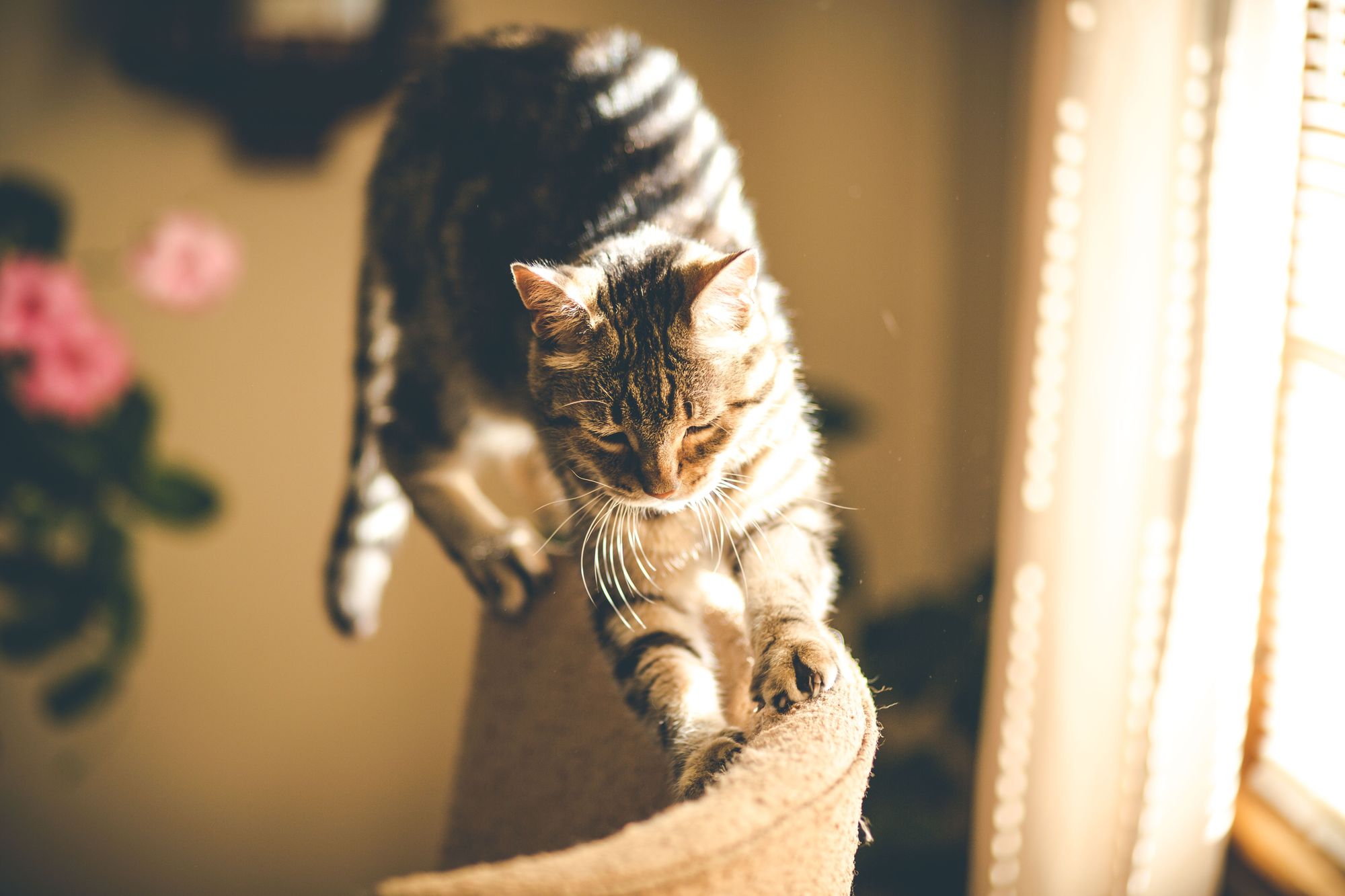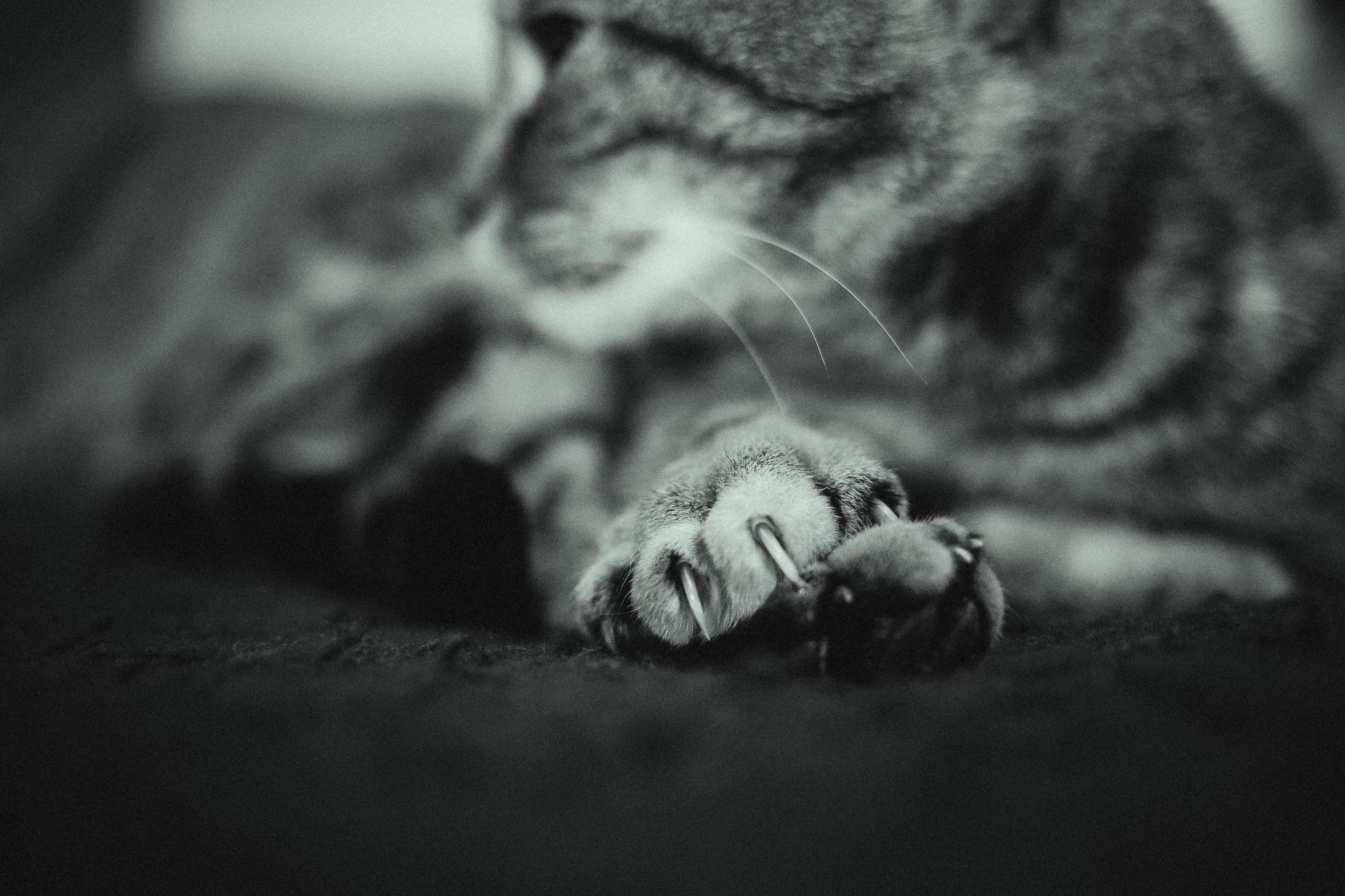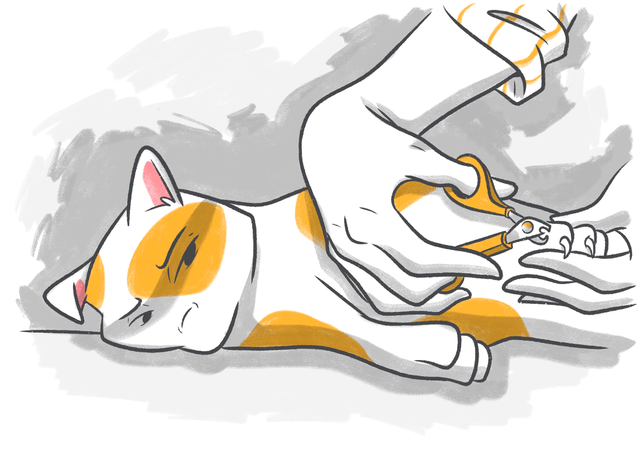We all know a cat scratch can sting, and their scratching can wreak havoc on any surface or object in your home. Many of us aren’t even sure if cats should have their nails trimmed. Also, trimming a cat’s nails can be a daunting task, as we fear the wrath of our feline friends just as much as we fear hurting them by cutting them quickly.
Unfortunately for us, regular nail trimming is the secret to keeping your feline friend and household in perfect harmony. So let’s look at how to disarm your cat's murder mittens without causing grievous injury to your cat or yourself.
Stop Googling - Ask a Real Vet
Content:
- Our Simple Guide to Trimming Nails in Your Cat
- Anatomy of Claws in Your Cat
- What Are The Risks Of Trimming Nails in Your Cat
- How To Trim Feline Nails
- How Often Should You Trim Nails in Your Cat
- Cat Nail Clipping Tools
- FAQ
- Conclusion
Our Simple Guide to Trimming Nails in Your Cat
To follow our simple guide to trimming your cat's nails, gather cat nail clippers, styptic powder, and treats. Find a calm environment and help your cat relax by holding and stroking their paws. Gradually introduce the clippers and trim the nails at a 45-degree angle, avoiding the quick. Take breaks if your cat becomes anxious.
But let’s start by looking at the anatomy of a cat’s claws.
Anatomy of Claws in Your Cat
Understanding the structure of your cat's claws is crucial before attempting to trim them. Your cat's claws, made of keratin, grow directly from the phalange muscles in their toes.
The sheathes (the sharp nail) and phalanges (bones in their toes) are connected by nerves and blood vessels. These sensitive nerves and blood vessels reside within the pink area of your cat's nails (known as the 'quick'). They provide the nail with the essential nutrients it needs to survive. But cutting quickly causes a lot of bleeding, pain, and havoc.
According to veterinary sources, those nerves and muscles are what allow cats to retract their claws. Before cutting their nails, make sure you can tell the difference between the outer nail and the inner quick. If you gently pinch your cat’s toe until the nail is visible, you should be able to see the opaque white part, which is the nail, and the inner pink bit, which is quick and you don’t want to cut.
Don’t worry if your cat’s nails are black and you can’t see the quick; we’ll explain how to deal with that below.
What Are The Risks Of Trimming Nails in Your Cat
Before clipping a kitten's or cat’s nails, you should know why your cat has claws and what they use them for to know if there are any downsides. If your cat is accustomed to trimmed nails, they'll likely be less inclined to roam around. On the other hand, an adult cat that relies on its claws may put up a bit of a struggle.
The BSAVA study on cat health and welfare highlights the importance of scratching. The stretching motion during scratching is essential for many aspects of their physical health, including muscle strength, agility, mobility, and even skeletal health. Having nails that are too short might interfere with this natural behavior.
Other downsides include:
-
If not done carefully or if the cat is resistant or fearful, there is a risk of accidental injury. Cutting the nails too short may cause bleeding and pain. Additionally, if the cat struggles or becomes agitated during the process, there is a possibility of unintentional scratches or bites.
-
Cats are often sensitive to handling and restraint. Trimming their nails can be stressful for some cats, leading to anxiety or fear. This can make the process challenging for both the cat and the person performing the trimming.
-
If the cat has a negative experience during a nail trimming session, they may develop an aversion to future nail trims. This can make subsequent attempts more difficult, as the cat may become more resistant or aggressive.
-
Some cats may simply not tolerate having their nails trimmed. They may struggle, resist, or become aggressive, making it challenging to complete the task safely and effectively.
How To Trim Feline Nails

Once you've gotten the hang of following our easy and convenient guide to trimming your cat's nails, it'll become a stress-free routine with just a little patience and practice. Let's dive into the step-by-step process:
-
Gather the necessary supplies: Get your hands on a pair of cat nail clippers and some styptic powder (just in case of any bleeding mishaps). Don't forget tasty treats to reward your cat.
-
Find a calm environment: Choose a peaceful and comfy area where you and your cat can be calm during the nail trimming session.
-
Get your cat nice and cozy: Gently hold and stroke their paws to help them relax. Slowly introduce the clippers, allowing them to sniff and investigate the tool.
-
Time to trim: Hold the clippers at a 45-degree angle and carefully clip the tip of each nail. Take it slow with small cuts to avoid getting too close to the quick. If your cat starts feeling anxious or uncomfortable, take a break and try again later.
-
Reward and praise: After each successful trim, shower your cat with treats and praise. This positive reinforcement will help them associate nail trims with positive experiences.
Trimming dark or black nails is a bit trickier if you can’t see the quick. Holding a flashlight against the nail can sometimes show you where the quick is. Alternatively, make a conservative cut right at the tip of the nail.
How Often Should You Trim Nails in Your Cat
How often you trim your cat’s nails depends on your cat's lifestyle, age, and the health of their claws. As a general guideline, trimming your cat's nails every 2 to 4 weeks is recommended. Studies have shown that cats often sharpen their nails on rough surfaces, affecting how often you'll need to trim them.
Some cats may need more frequent trims if their nails grow rapidly or if they have a laid-back lifestyle (especially indoor cats) and don’t spend much time at the scratch post. On the other hand, outdoor cats wear down their nails naturally and require fewer trims.
Keeping an eye on your cat's scratching behavior when you're away from home becomes easier with the help of a Petcube Camera. It lets you observe your cat's scratching habits remotely, helping you spot any destructive clawing and decide how often to trim their nails.
Cat Nail Clipping Tools

Selecting the right tools to trim your cat's nails can make the process a breeze while keeping everyone safe. Here are the essential cat nail-clipping tools you'll need:
-
Cat Nail Clippers: Opt for clippers specially designed for cats, as they have a curved blade that follows the nail's natural shape. Scissor-style or guillotine-style clippers are commonly used, so choose the type that feels most comfortable.
-
Styptic Powder: Accidents happen, and that's where the styptic powder comes to the rescue. It helps stop bleeding by promoting blood clotting, so it's a handy tool to have nearby, just in case.
-
Treats and Rewards: Positive reinforcement is key during the nail-trimming process. Stock up on your cat's favorite treats to reward their cooperation and create a positive association with nail trimming.
FAQ
What Happens If You Don't Trim Your Cat's Nails?
If you don't trim your cat's nails, they can become excessively long and sharp. This may lead to discomfort, difficulty walking, snagging on objects, accidental scratching of furniture or people, and potentially ingrown nails or other foot problems.
How Short Should You Cut Your Cat's Nails?
When trimming your cat's nails, aim to remove only the sharp tip, avoiding the quick (the pink area inside the nail). Generally, a safe guideline is to trim about 1-2 millimeters from the tip of the nail. However, individual variations and nail conditions should be considered.
What Should I Do If I Cut My Cat's Nails Too Short?
If you accidentally cut your cat's nails too short and they start bleeding, remain calm. Apply gentle pressure with a clean cloth or styptic powder to the bleeding area to help stop the bleeding. Comfort your cat and provide a quiet, stress-free environment while monitoring the bleeding. If bleeding persists or you are concerned, consult a veterinarian for further advice.
Conclusion
Regular nail trimming is the key to preventing unwanted accidents and damage. By understanding the anatomy of your cat's claws, learning the proper technique, and using the right tools, you can easily and safely trim your feline friend's nails.
Was this article helpful?
Help us make our articles even better









